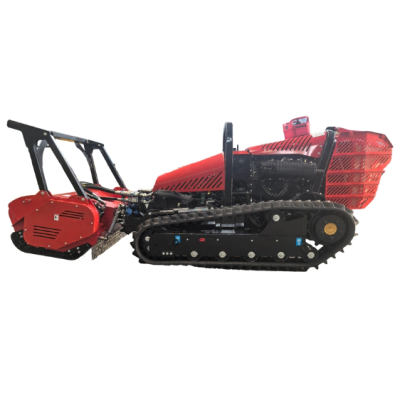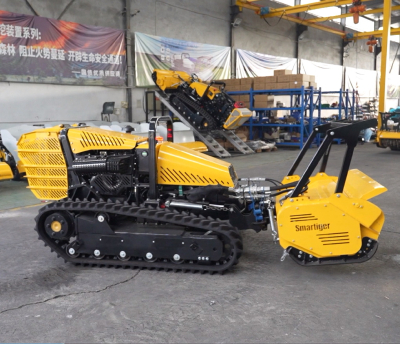Concentrated Weed Control Campaign at Photovoltaic Power Stations: Technology Empowers Safety, Ecological O&M Drives Development
As summer rainfall increases, weeds in the campus areas of photovoltaic (PV) power stations within the jurisdiction have entered a phase of rampant growth. Overgrown and dense weeds not only block PV panels from absorbing sunlight—causing a significant drop in photovoltaic power generation efficiency—but also pose severe safety hazards. Once dry, these weeds can easily ignite when exposed to high temperatures from electrical equipment or open flames, triggering fires. Meanwhile, weeds 缠绕 (entangle) equipment wires and block maintenance access, also hindering the daily inspection and maintenance work of the power stations. To ensure the safe and efficient operation of PV power stations and enhance power generation benefits, the personnel in charge of the posts promptly mobilized resources, with remote-controlled lawnmowers as the core operation equipment, to launch a precise and efficient concentrated weed control campaign.
Precise Operation: Building Zone-Based Lines of Defense for Safety and Ecology
This weed control campaign did not adopt a "one-size-fits-all" cleaning approach. Instead, based on the functional requirements of different areas in the PV power stations, differentiated operation plans were developed. By leveraging the flexible operation advantages of remote-controlled lawnmowers, the goal of "achieving win-win results for both safety and ecology" was realized.
Key Safety Locations: Thorough Removal to Build a "Firewall"
For key safety locations—such as fire isolation belts, critical fire-fighting areas (e.g., the vicinity of inverter rooms, both sides of cable trenches), and inspection/maintenance access routes—operators used remote-controlled lawnmowers to conduct "carpet-style" thorough cleaning. Equipped with high-strength cutting blades, these remote-controlled lawnmowers can easily cut through weeds and shrubs over 1 meter in height. Their compact and flexible bodies allow free movement in the gaps between PV panel arrays and narrow spaces around equipment, preventing mechanical collisions with devices. During the cleaning process, staff strictly followed safety standards to cut weeds down to 5 centimeters below the ground surface. At the same time, the cut weeds were promptly removed and transported away to prevent them from piling up after drying and creating fire risks. After cleaning, the fire isolation belts achieved a state of "no weeds, no flammable materials," while critical fire-fighting areas and inspection/maintenance access routes featured unobstructed visibility and smooth passage—building a solid safety line of defense for the power stations.
Ecologically Sensitive Areas: Scientific Suppression to Balance "O&M and Ecology"
For ecologically sensitive areas in the power stations—such as non-planted green spaces (e.g., green belts at the edges of the campus, native vegetation areas under PV panels)—the personnel in charge abandoned the "full removal" model. Instead, they used remote-controlled lawnmowers to precisely control the growth rate of weeds. During operation, staff adjusted the cutting height of the lawnmowers to retain low-lying vegetation. This approach not only prevents weeds from blocking PV panels and affecting power generation but also maintains the stability of the ecological environment in these areas, preserving habitats for small insects, birds, and other organisms. Meanwhile, for areas under PV panels where weeds tend to grow prolifically, operators regularly performed "light trimming" using remote-controlled lawnmowers, keeping weeds at a height below that of the PV panels over the long term. This not only reduces the frequency of manual weeding and lowers O&M costs but also achieves the harmonious coexistence of "PV operation and maintenance and ecological protection."
Efficient Guarantee: Technology Empowers Enhanced Operation Efficiency
Compared with traditional manual weeding, the application of remote-controlled lawnmowers significantly improved the efficiency of this weed control campaign. In traditional manual weeding between PV panel arrays, each worker could only cover approximately 5,000 square meters per day. Additionally, this method was plagued by high labor intensity and significant safety risks (e.g., high-altitude operations, contact with electrical equipment). In contrast, remote-controlled lawnmowers operate 8 to 10 times more efficiently than manual labor. Moreover, staff only need to operate the equipment via remote controls from safe areas, eliminating the need to enter equipment-dense or narrow spaces—effectively avoiding safety risks such as electric shock and equipment collisions.
To ensure operation quality and progress, the personnel in charge also established a "zonal responsibility system." The power stations were divided into multiple operation zones, with each zone equipped with 1 remote-controlled lawnmower and 2 staff members (1 operating the machinery, 1 inspecting quality). A brief pre-operation briefing was held daily to clarify the day’s operation area, standards, and safety precautions. After operations, the cleaning results were inspected against the standards to ensure "each zone is inspected and accepted only after meeting the requirements." Furthermore, to address potential disruptions from rainy weather, staff checked weather forecasts in advance, adjusted operation plans reasonably, and focused on advancing work during sunny periods to ensure the weed control campaign was completed on schedule.
From an ecological perspective, vegetation in ecologically sensitive areas has been effectively protected, and the ecological environment within the campus remains stable—achieving the organic unification of "safety, efficiency, and ecology."
This concentrated weed control campaign not only effectively eliminated safety hazards caused by weeds and ensured the stable operation of PV power stations but also explored a new PV power station management model of "technology-empowered O&M + ecological protection" through scientific operation methods. In the future, the personnel in charge will further establish a regular weed inspection and control mechanism, conduct regular weeding operations using intelligent equipment such as remote-controlled lawnmowers, and continuously enhance the refined level of PV power station O&M. With stable output of clean electricity, they will contribute to rural revitalization and inject impetus into the green development of the region.




